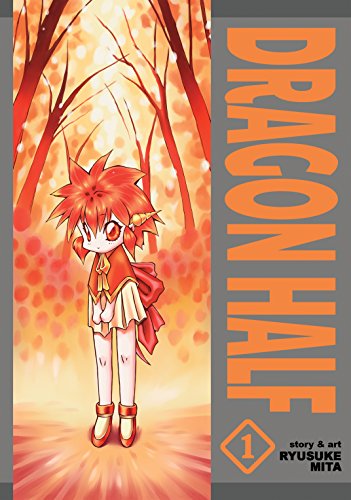By Ryusuke Mita. Released in Japan as two separate volumes by Fujimi Shobo, serialized in the magazine Dragon Magazine. Released in North America by Seven Seas. Translated by Andrew Cunningham. Adapted by David Lumsdom.
In another world, this sort of title would have been licensed around the time it came out, back in the late 1980s/mid-1990s, when its art style and sort of humor were far more common and appreciated, and the anime had become a cult classic due to its over the top humor and pacing. Of course, back in 1994 or so when the Dragon Half OAVs came out, and the manga had just finished its run, the “manga scene” did not really exist as such – we’re talking a time when Mai the Psychic Girl was the hot thing, and Ranma 1/2 was still in 32-page pamphlet form. Still, what goes around comes around, and a lot of the cliches that were ripe for mocking in the late 80s RPG/fantasy scene are still ripe for mocking. And thus, despite artstyle and personalities that remind me a bit of Urusei Yatsura, Dragon Half manages to be a heck of a lot of fun, which is surprising given that humor titles tend to wear out faster in omnibus format.
I must say, the cover does the title no favors – Mink is a lot more dynamic than the passive little girl figure we see there. She’s the daughter of a human adventurer and a dragon, who can helpfully turn human when she wants to. As such, Mink has certain advantages like super strength and flight, but also has teenage girl obsessions, such as the teen idol (and also adventurer) Dick Saucer. (Yes, he’s named Dick Saucer in Japanese.) Unfortunately, Mink is half-dragon, and Dick is dedicated to killing dragons. Poor Mink! Can her feelings ever get through to him? Well, no, but nobody really cares, because the plot is just an excuse for Mink and her two friends (the airhead “bi-curious” Lufa and the childish always-armored Pia) to go around having adventures and making fun of everything that 80s RPGs and bad fantasy novels had to offer.
Everything in Dragon Half is subservient to the humor – and there are a lot of laughs, all of the “broad comedy” variety. If you’re looking for subtlety, look elsewhere, but if people getting hit with rocks is your thing, you’re in the right place. Surprisingly, Mink ends up being the “straight man” for much of the volume, using her semi-superpowers to bail her foolish friend out of trouble (yes, friend – Pia usually just goes along with things, but Rufa is actively harmful most of the time). She’s be in danger if the villains were any threat at all, but from the evil princess who’s really a slime in disguise to the soldier who brags that the tiny size of his brain is an advantage, Mink can usually do pretty well for herself. Towards the end of the volume (as the author notes) there are one or two stories that actually have a semi-serious tone, but fortunately they fit in pretty well, and more jokes are just around the corner.
This is the first of three omnibuses schedules, and is filled to the brim with extras such as color pages, promotional artwork, and author commentary. It’s a good title if you like humor, a great title if you enjoy mocking old-school games, and essential if you’re nostalgic for the late 80s-early 90s style of manga art and characterization.

